Excerpts from Jim Conrad's
Naturalist Newsletter
Entry from field notes dated September 1, 2023, taken in Los Mármoles National Park in the Eastern Sierra Madre mountains, Hidalgo state, MÉXICO; forested ridge near fork in road leading to Puerto de Piedra, on road between town of Trancas {on maps designated "Morelos (Trancas)"} and Nicolás Flores; oak/pine forest on limestone bedrock; elevation ~2,300m (~7,550ft); ~N20.80°, ~W99.24°
PINYON RICEGRASS
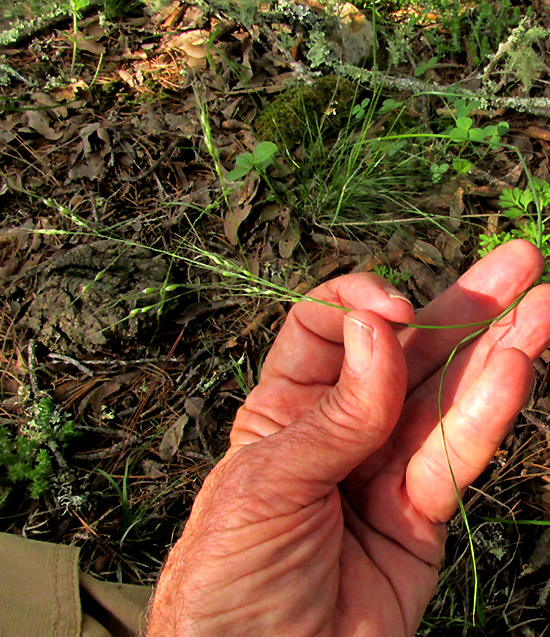
On a forested ridge sometimes grazed by roaming cattle, the above grass caught my eye because it was one of very few grass plants scattered about on the forest floor, and its inflorescence bore particularly large, plump spikelets. It was a small grass with a diffuse flowering head, thus hard to photograph amid background clutter. Above, note that the grass's stem, or culm, is bent around with the inflorescence in my hand, and the tuft of grass producing it a little above my hand, on the forest floor.
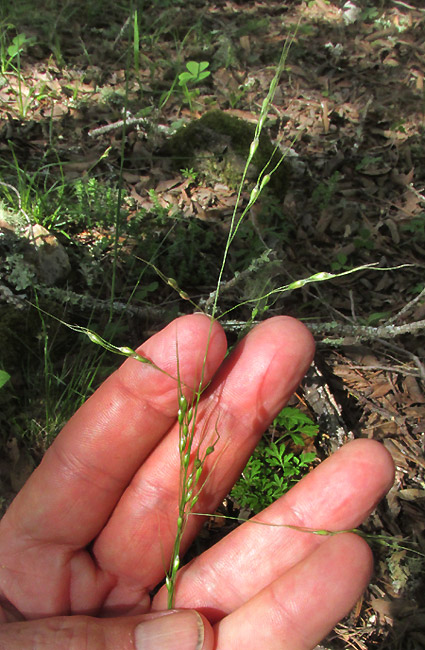
The seed-dispersal strategy of most species of the enormous Grass Family, the Poaceae, is to produce many small seeds, accepting that the vast majority will never produce adult grasses. This grass opts for making a few larger seeds, the seeds thus providing more stored nutrients for germination, increasing the seeds' chances for survival. This grass's spikelets tend to separate from one another on widely spreading branches off the main rachis, perhaps making it harder for birds to snatch grains from the diffuse head.
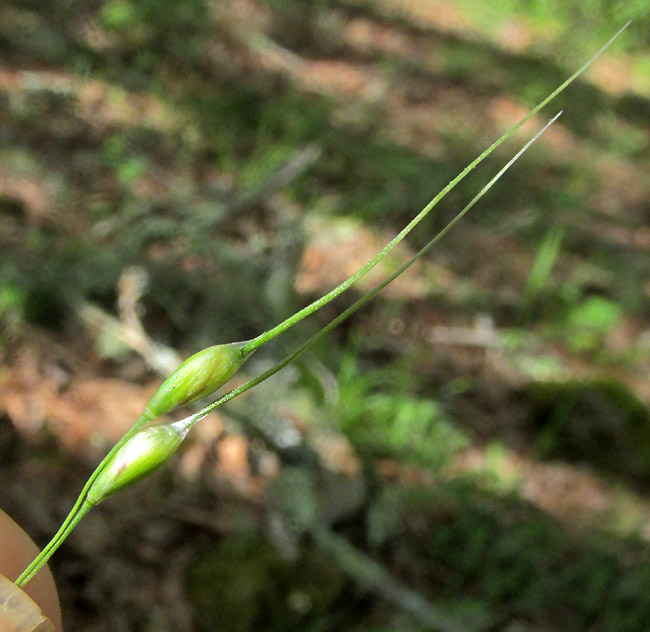
Each spikelet arose from a long, slender branch off the rachis, the rachilla, and atop each spikelet grew a similarly long, slender, needle-like spine, or awn.
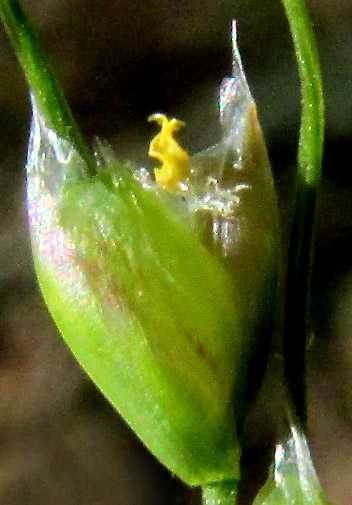
The above spikelet is flowering, exposing its its yellow anthers. Grass identification heavily depends on analyzing spikelet structure. Important features displayed above include the spikelet containing a single floret, not two or more; the spikelet is exceptionally plump, generally oval in shape; and the big, scale-like outer glume occupying the picture's bottom, left corner is unusually wide, bearing 5-7 obscure veins.
Note that the awn doesn't arise from the tip of one of the enveloping glumes, but rather from the shorter, scale-like lemma embracing the floret within the glumes. Each floret is wrapped within a lemma and a palea, both scale-like and textured like very thin paper. The picture shows only the lemma and palea tips, but it's seen that the lemma and palea are about the same height; that's a feature helpful for determining the grass's genus.
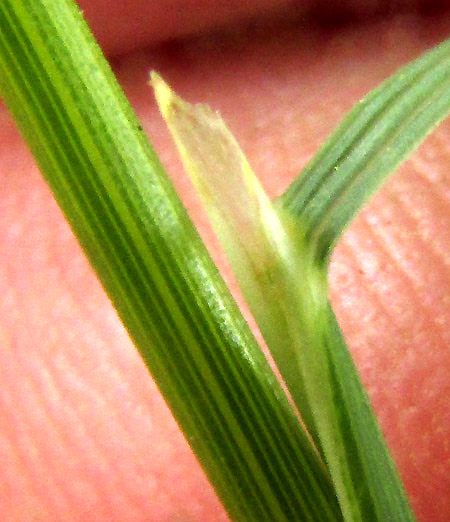
Where grass blades meet their stems, often there's some kind of appendage, the ligule, which at the right is the pale item in the image's center. Ligules, when present, develop into many forms, from lines of hairs to solid scales, depending on the species; they're good fieldmarks for grass identification. Traditionally ligules have been assumed to keep water, dust and the like from accumulating in leaf axes, but they seem to be too complex just for that, so the matter still is being studied. Our grass's ligule is unusually tall and robust looking, with no teeth or lobes. Here's a closer look at the perennial, tuft-forming grass body:
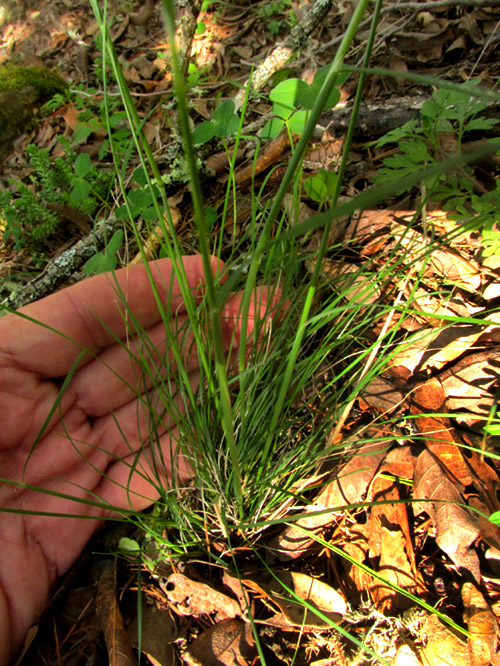
From among the 12,000 or so Grass Family species, the above-mentioned features pointed to the 600 or so species comprising the tribe Stipeae. The Stipeae are distinguished by their spikelets producing a single floret, the lemmas' tips bearing needle-like awns, and the inflorescence branches, the rachillas, not extending beyond the spikelets. Within the Stipeae, features seen in the photos limit the possibilities to three or so genera.
At this point in the identification process it becomes more helpful to consult the 2021 work by José Luis Villaseñor and others entitled "Riqueza y distribución de la flora vascular del estado de Hidalgo, México," to know which species of the candidate genera occur in Hidalgo state, so that our plant can be compared with identified pictures of each of those species on the Internet. With the branches of our grass's inflorescence so widely spreading, the spikelets being so plump and the awns so long and twisty, and with the grass growing alone on the floor of an oak-pine forest, our plant reveals itself PIPTOCHAETIUM FIMBRIATUM.
In English the species is known as Pinyon Ricegrass, despite Piptochaetium species more typically being referred to as speargrasses. Our plant is a ricegrass because of the thick rice-like grain developing from its fat spikelets.
Our grass has an English name because it's found in upland oak and Pinyon Pine woods of the southwestern US, from New Mexico into western Texas. However, it's main distribution area is throughout the Mexican highlands south as far as, barely, Guatemala. The genus Piptochaetium with its 27 or so species is mostly a South American one, with its center of diversity in Argentina. In Hidalgo state, four species have been documented.
The 1990 paper by Rex Pieper entitled "Overstory-understory relations in pinyon-juniper woodlands in New Mexico" provides data suggesting that Pinyon Ricegrass with its high tolerance for low light intensities and other conditions associated with high canopy cover, is adapted for old-growth forests which are near or have reached their final stage of successional development, their climax stage. With its wandering cattle and occasional firewood gatherers, our Hidalgo forest no longer is in its climax stage, but until now our grass has been able to survive, apparently as a relict species from less disruptive times. Eventually it may no longer be able to compete with species thriving on more sunlight.
Cattle and wildlife such as deer feed on Pinyon Ricegrass, and various quail species and Wild Turkeys have been documented eating the grains.
Entry dated November 7, 2023, from notes taken near Cascadas de La Piedad waterfall 3kms NW of the community of San Pablo, municipality of Almeaco de Bonfil; bedrock of thick layers of compacted volcanic ash, or tuff; N20.1024°, W100.0019°, elevation 2360 meters (7750ft); extreme southern Querétaro state, MÉXICO
PINYON RICEGRASS'S MATURE SPIKELETS
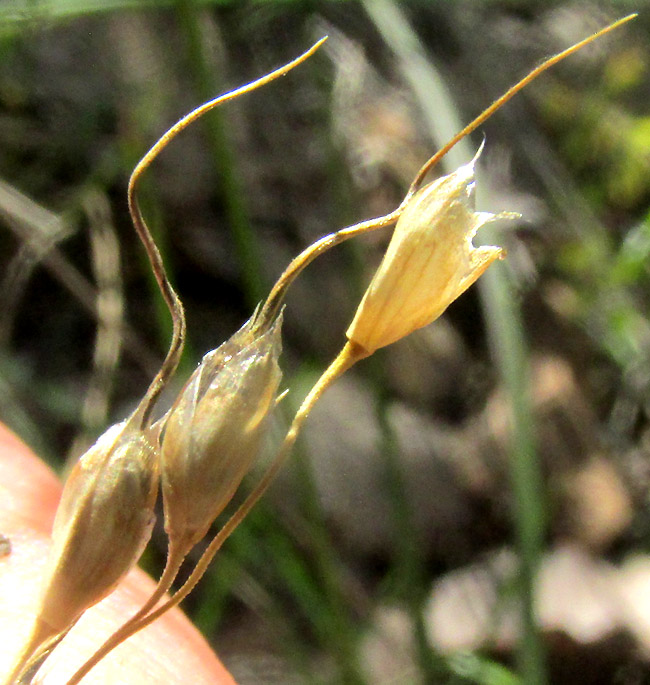
Later in the year and at a different location, but at about the same elevation in an oak forest, Pinyon Ricegrass spikelets are mature and dropping their one-seeded, caryopsis-type fruits. Above, the top floret has lost its caryopsis, leaving the glumes and lemma behind. Notice how the needle-like bristles twist and curl. I have read that in other species with such bristles, alternating moistness and dryness causes them to twist and untwist, possibly helping them burrow into the soil.